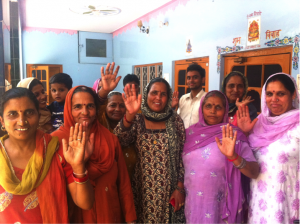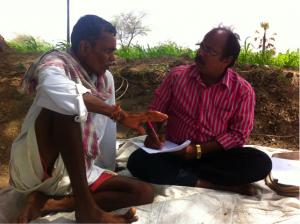How useful is climate information to smallholder farmers in India?

By Arame Tall
Progressive women farmers from the village of Amtrar, in Northern India, nested at the foothills of the Himalayas, wave us goodbye as we finish our day-long discussion with them to capture their assessment of the reach and practical usefulness of receiving agro-meteorological advisories for their livelihoods and farming decisions.
Since June 18, 2012, a field team from the CGIAR Research Program on Climate Change, Agriculture and Food Security (CCAFS) has been on a mission across the five corners of India to interview farmers. This in an attempt to document their perspectives on the added-value of climate services for agricultural decision-making. Through India Meteorology Department (IMD)’s national Agro-meteorological Advisory Service (AAS) program, farmers across the country have been receiving, for a number of years, weather-based, crop-focused agro-meteorological advisories. These provide practical advice on when to planting, irrigation, what pesticide and fertilizer to use at the correct timing as well as other relevant agricultural support services. The data have been based on a five day short-range weather forecast, produced by the India Meteorology Department.
India’s Agro-Meteorological Advisory Service Program is one of the longest operating agro-met advisory programs in the world, started in 1981 following a national initiative from then Prime Minister Indira Ghandi following a severe famine caused by a weather shock.
One of the AAS program’s main achievements between 1981 and 2008, when the program went national under IMD, has been its integration of weather and climate information (summary of preceding week, normal climatology for week, short-range weather forecast) and crop information (type, state and phonological stages of crops, information on pests and disease, and crop stresses), to produce advisories focused on farmers’ specific decision-making needs within the season. The advisories are produced by teams of multi-disciplinary agricultural research scientists, who interpret weather forecast in light of what it means for the various crops and farming practices of the region they cover. Finally, agricultural extension officers with others, disseminate the agro-meteorological advisories down to farmers, using innovative communication channels such as SMS, CBOs and farmer clubs, with built-in channels for farmer feedback to agricultural scientists and national forecasters.
Within the auspices of a South-South learning agenda on climate services, recently launched by CCAFS Theme 2: Climate Risk Management, the aim is to understand how farmers, living at the frontlines of  a changing climate, assess the practical relevance of the AAS program to their lives and livelihoods. As well as their perspectives on the role of agro-met advisories in making more informed decisions under an increasingly variable, and unpredictable climate.
a changing climate, assess the practical relevance of the AAS program to their lives and livelihoods. As well as their perspectives on the role of agro-met advisories in making more informed decisions under an increasingly variable, and unpredictable climate.
By the end of this study, a total of 18 villages in six states across India’s main agro-climate zones will have been sampled, for a total of 900 farmers interviewed – half of whom will be women farmers. In each village, separate focus groups of men and women farmers are interviewed, to delve into the equity challenges in reaching the most vulnerable farmers with agro-meteorological advisories.
One of the specific interests of this study is to derive best practices in delivering salient farmer-focused climate services, as well as areas for improvement, for the consideration of other countries across CCAFS target areas where such weather-based agricultural support services have not yet taken off.
Preliminary findings are already revealing that farmer-focused climate services do influence farming decisions and can transform lives. This provided that scientists transition from providing weather information to producing advisories. Advisories that are produced in a manner that keeps the decision-making needs of farmers at the center and reaches the most vulnerable farmers in the country’s most remote villages.
The findings from the India case study, along with other successful stories of farmer-focused across Africa, will be presented at a South-South workshop planned by CCAFS, in collaboration with the World Meteorological Organization (WMO) and USAID for 5-7 November, centered around the theme of “Delivering salient Farmer Focused Climate-Services: How to Do it Right?”.
This blog post was written by Arame Tall, researcher within Theme 2: Adaptation through managing climate risks. For further information on the India AAS case study assessment, please contact a [dot] tall [at] cgiar [dot] org (Arame Tall) directly.
To get more updates on our research in South Asia, follow us on Facebook and Twitter @Cgiarclimate.


